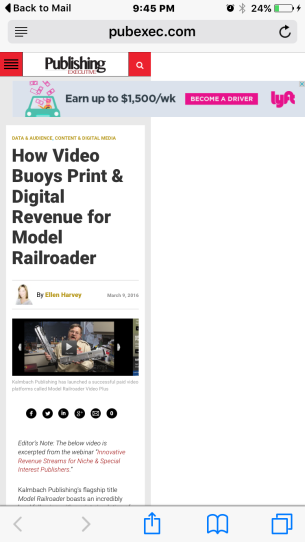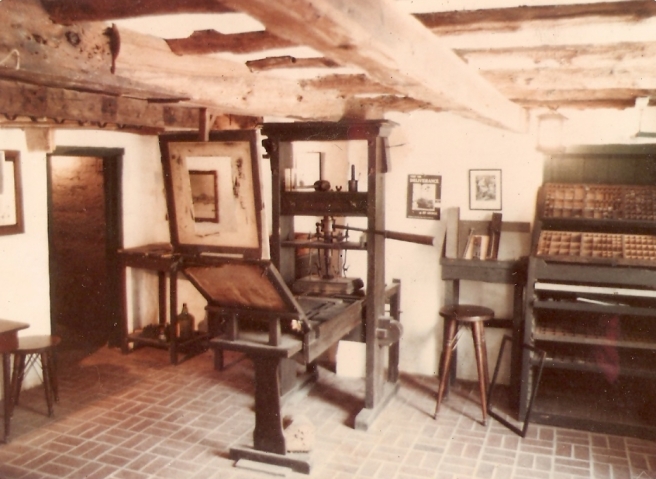
Because it delivers no value to anyone:
Readers, advertisers, or publishers.

Because it delivers no value to anyone:
Readers, advertisers, or publishers.
This is a 25 minute keynote address at a media conference, so make some popcorn.
Some of it is a list of talking points to please Wall Street, but a lot of it is right on.
A lot of what he says are things that I have talked about, some are hauntingly similar to the speeches I gave to my editors at Hanley Wood.
1. Print his not going away, but it is increasingly irrelevant to how people live their lives. It is declining 5-10% per year.
(This is consistent with what I have seen in the construction media space, both B2B and B2C; digital is increasing about 15-20%/year).

When Gutenberg invented the printing press, he made the job of making books a lot easier. The Monk monopoly on bookmaking was over, so it sucked to be a monk. Fortunately, monks learned how to make really good beer, and in the long run, that is a good thing, because beer is good. Because the job of making books was made easier, the portable book was born and soon after the precursors of newspapers. With portable books and newspapers came the occupation of editor. (I am not sure if more beer and more editors are a causal or correlational Continue reading
Nielsen’s App Playbook is a survey of almost 4,000 app users on both smartphone (~3,700) and tablet (~1,000). It set out to document usage behavior for mobile apps as opposed to mobile web use. They found that people download more apps than they need (only using about a quarter of those they download), but Continue reading
A couple of posts ago, I quoted an acquaintance of mine named Sean Griffey. Sean started Industry Dive, a mobile B2B media company in DC a few years ago and they have been adding verticals lately. They are up to nine right now. This contrasts with print B2B media companies who are shuttering magazines or cutting frequency. As most of you know, growing is usually better than shrinking in the business world.
I recently read an article by Bill Mickey on foliomag.com about another digital B2B publisher with print in its crosshairs: Aggregate. This company just secured a pile of cash Continue reading
This article: A Digital Transformation for Science in the Columbia Journalism Review, illustrates a couple of important aspects of the digital-first movement in magazine-land.
The gist of the article:
To reach out to a new generation of scientists, Science (correctly) wanted to become a digital-first media company. They brought in someone who had run a transition at Nat Geo, and they moved forward with it. Continue reading
I hate email almost as much as I love it.
What bothers me most about email how much it can hijack the productivity of a team. One of my favorite podcasts, Manager Tools, has a lot of great podcasts on the topic. Harvard Business Review has a blog about it too, The Cost of Continuously Checking Email
HBR says that it is a good idea to turn notifications off and schedule times to check email, i.e., once in the morning, once after lunch and once in the evening. Manager Tools agrees with this, and so do I. Sometimes you MUST stare at your inbox waiting for critical messages, but I’d wager that is extremely rare. Continue reading
 Newsletters are a fantastic way to connect with your digital audience. They are like the magazine of the digital world (Digital magazines are NOT the magazine of the digital world, but that’s another topic altogether). Because we call them newsletters, we treat them like print newsletters: a couple of columns, photos, and a lot of text. We assume that readers will want this because that’s what we have fed them in print-world.
Newsletters are a fantastic way to connect with your digital audience. They are like the magazine of the digital world (Digital magazines are NOT the magazine of the digital world, but that’s another topic altogether). Because we call them newsletters, we treat them like print newsletters: a couple of columns, photos, and a lot of text. We assume that readers will want this because that’s what we have fed them in print-world.
I am throwing down the gauntlet and saying that it is wrong. Here are ten reasons to NOT use images in your email newsletters.
1. They load faster
Nothing slows down quick-hit info packets like slow-to-load content slugs. Worse, if your overworked producer is taking shortcuts and not optimizing the images for email (reducing the resolution, sizing the image properly, etc.) the content slug gets even logier.
Continue reading
Here’s an excerpt from a letter I wrote to a publishing buddy of mine. It is about how media companies can dig their way out of the hole they find themselves in: print revenue is still down, digital revenue may be up, but not enough to cover print’s losses, staffs still cut to the bone, and seemingly double the deliverables with editors being forced to make magazines and also feed the websites.
Dear Poncho,
I’ve been thinking long and hard for at least a few years about how the publishing industry will salvage their brands in media’s shifting landscape.
A publishing company I worked with recently had some very similar demographics to what I saw at yours:
Dan’s efficiency tip of the [time period*]:
As a professional, it is your responsibility to find ways to cut time from everyday tasks. If it takes you an hour to do something, figure out how to do it in 55 minutes, or 50 minutes. If you do that with a few tasks, then you’ve just gained 10% efficiency. Now you can do more with your 40 hours.
In carpentry, its akin to marking the edge of a stud and using a speed square as a cutting guide, rather than marking the stud, getting out your speed square, drawing a line, putting your pencil and speed square away, and then cutting the stud.
Continue reading